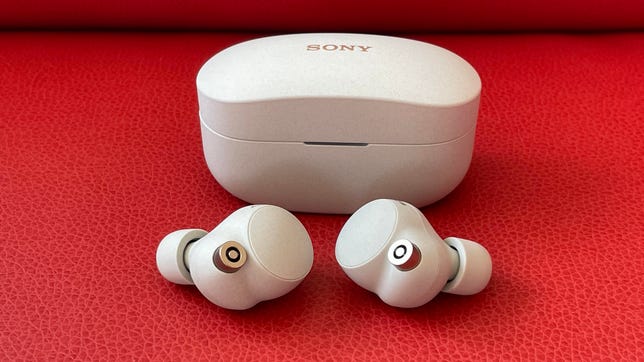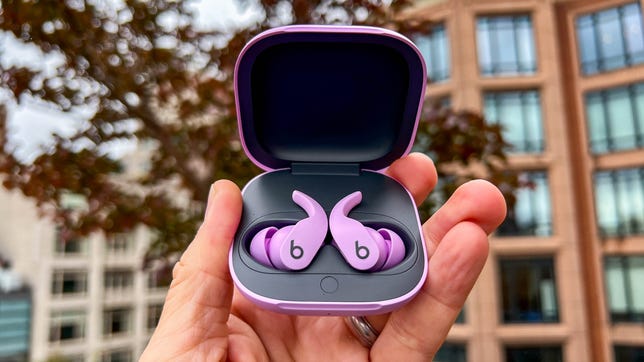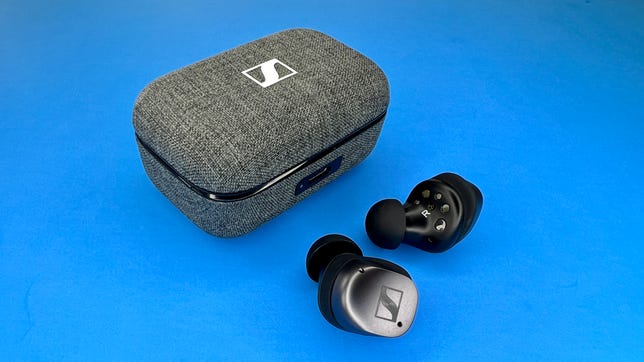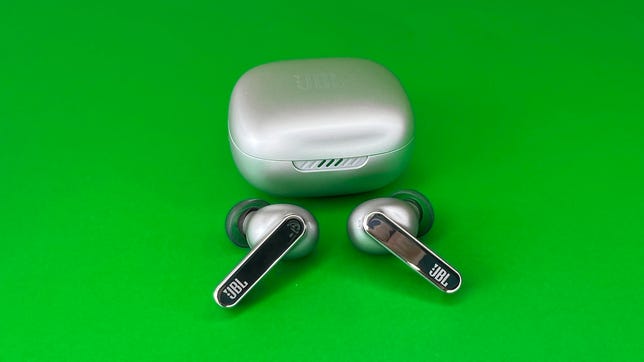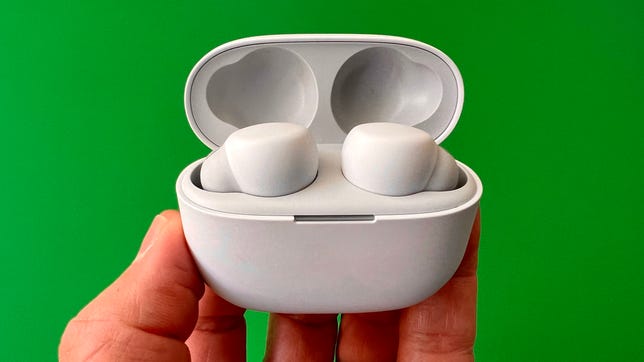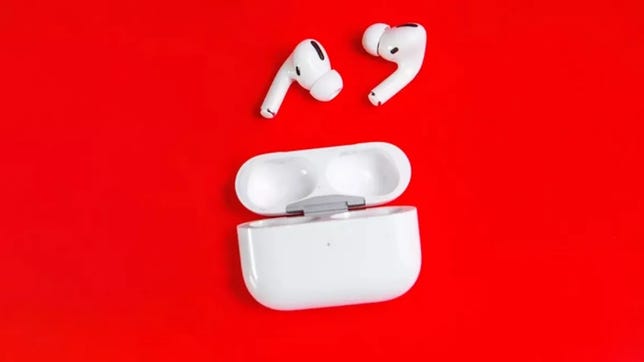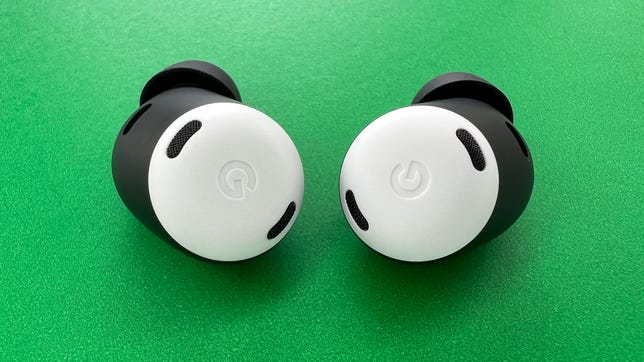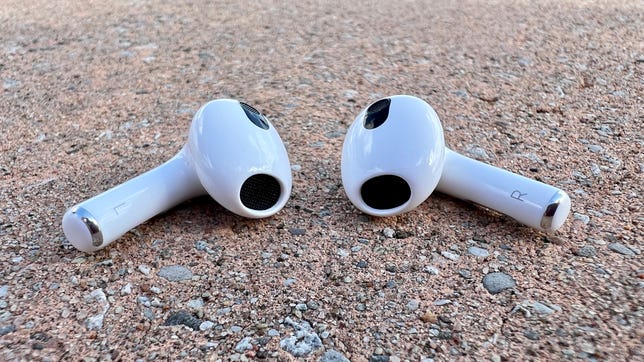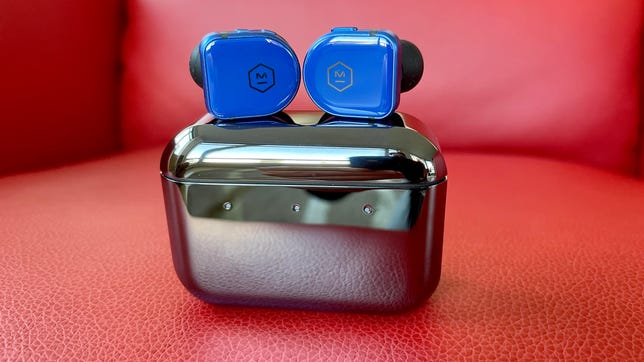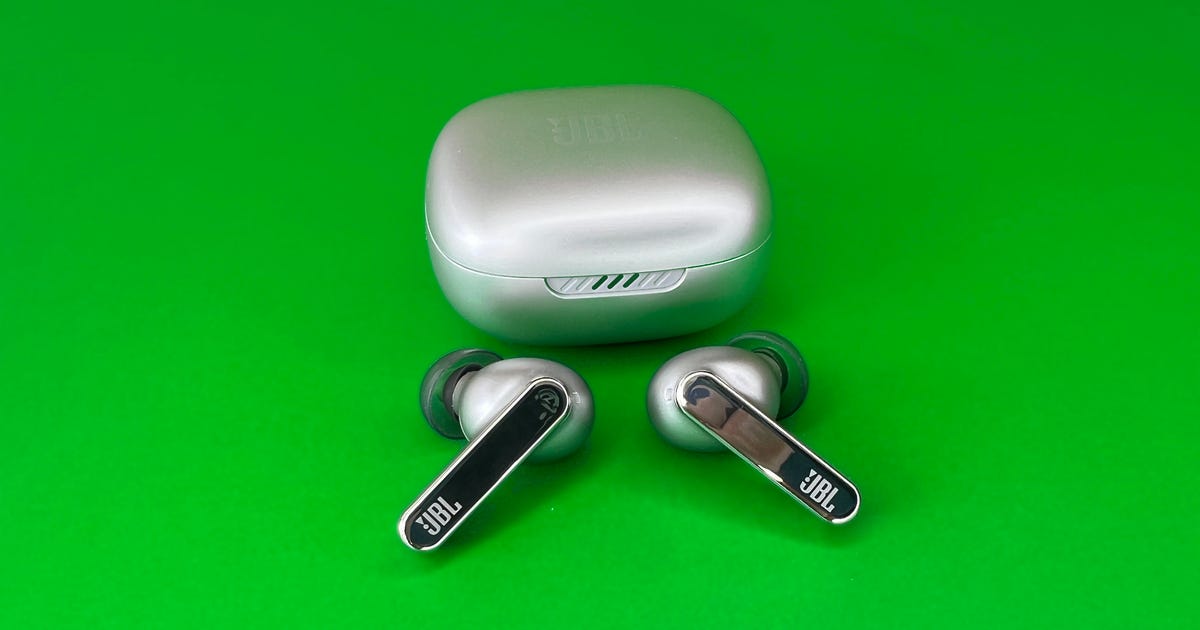
If you’re searching for the best wireless earbuds, you’re probably really after the best true-wireless earbuds. Sure, you can still find Bluetooth earbuds that have cord between the buds, but the most popular and best earbuds are completely wireless, so that’s what this list is all about: the best true-wireless earbuds.
In terms of style, some wireless earbuds are equipped with ear tips while others have an open design without tips (those are best for people who don’t like to have ear tips jammed in their ears and want to allow some sound in from the outside world). For the most part, only “noise-isolating” earbuds with silicone or foam ear tips offer active noise canceling — or noise cancelling (with a double l), as Bose and Google spell it — a feature that was once a rarity but has now become standard.
Yes, the top true-wireless earbuds can be pricey, but you can get surprisingly good ones for less than $100 — or even less. We regularly update this list as new top true-wireless earbuds hit the market.
CNET’s recommendations for the best wireless earbuds
David Carnoy/CNET
No earbuds are perfect, of course, and not everybody will love the fit of the Sony WF-1000XM4 buds or be able to afford their high price. But if you’re looking for great-sounding earbuds with active noise cancellation, solid voice-calling capabilities and good battery life, these buds check all the boxes.
Water-resistant: Yes (IPX4 rating — splash-proof).
David Carnoy/CNET
The Earfun Air Pro SV have a few things going for them. First, they sound shockingly good for a set of earbuds in this price range. They feature big, open sound with well-defined bass and good clarity. They’re also lightweight and comfortable to wear, their noise-canceling is effective and they have a fairly natural-sounding transparency mode that allows ambient sound in if you want to hear the outside world around you for safety reasons.
Earfun is highlighting how you can see the buds’ squared-off stems through the case — there’s a little window — but aside from the stems, the buds themselves have a similar shape and design to the AirPods Pro. While the case offers wireless charging, the buds are missing a sensor that pauses your music when you take them out of your ears (you can use a single bud if you want) and resumes playback when you put them back in. They’re IPX5 splash-proof, and battery life is rated at 6 hours with noise-canceling turned on. There’s also a low-latency gaming mode and touch controls that work reasonably well, and you can upgrade the buds’ firmware and tweak sound settings in a companion app for iOS and Android.
Earfun talks about them having “six professional mics for a stunning call experience” — and they work decently enough for calls — but I was slightly disappointed with the noise reduction while using them in the streets of New York City. Aside from that small gripe, they’re a very good value, particularly now that Earfun is offering them for $54 when you input the code SUMMER40 (40% off) at checkout on its site.
Water-resistant: Yes (IPX5 rating — splash-proof).
David Carnoy/CNET
Hot on the heels of the third-generation AirPods, Apple has another new set of earbuds, this time from its subsidiary audio company, Beats. Technically, the new Beats Fit Pro ($200) aren’t AirPods, but they’re built on the same tech platform as the AirPods Pro. Unlike Beats’ earlier and less expensive Studio Buds, the Beats Fit Pro include Apple’s H1 chip and have most of the AirPods Pro’s features, including active noise canceling, spatial audio and Adaptive EQ. I’d venture to call them the sports AirPods you’ve always wanted. And for some people, they might just be better than the AirPods Pro.
Water-resistant: Yes (IPX4 rating — splash-proof).
David Carnoy/CNET
The Sennheiser Momentum True Wireless 3 earbuds have excellent sound, improved noise canceling and voice-calling performance as well a smaller, more refined design with stabilizing fins (so the earbuds stay in your ears more securely). They’re among the best new true-wireless earbuds for 2022. They’re also one of the best true-wireless earbuds overall, giving the Sony WF-1000XM4 a run for the money.
Water-resistant: Yes (IPX4 rating — splash-proof).
David Carnoy/CNET
Over the years, JBL has put out some decent true-wireless earbuds, but nothing that really got me too excited. That’s finally changed with the arrival of the Samsung-owned brand’s new Live Pro 2 and Live Free 2 buds. Both sets of buds — the Live Pro 2 have stems while the Live Free 2 have a pill-shaped design — offer a comfortable fit along with strong noise canceling, very good sound quality and voice-calling performance, plus a robust set of features, including multipoint Bluetooth pairing, an IPX5 splash-proof rating and wireless charging.
The Live Pro 2 and Live Free 2 are equipped with the same 11mm drivers, six microphones, oval tubes and oval silicon tips. Aside from the design, the biggest difference between the two buds is battery life; the stemless Live Free 2 is rated for up to seven hours, while the Live Pro 2 is rated for 10 hours. The Live Pro 2 is available in four color options.
Water-resistant: Yes (IPX5 rating — splash-proof).
David Carnoy/CNET
Unlike the “open” LinkBuds, the LinkBuds S are traditional noise-isolating earbuds with tips you jam in your ears. They’re more compact and lighter than Sony’s flagship WF-1000M4 and also feature Sony’s V1 processor. While their sound and noise canceling don’t quite measure up to the WF-1000XM4’s, they’re close and cost less. They’re the Sony buds for people who can deal with larger buds like WF-1000XM4 but want 80 to 85% of those buds’ features and performance for $80 less.
Water-resistant: Yes (IPX4 rating — splash-proof).
Sarah Tew/CNET
While they’ve been out a while and the AirPods Pro 2 should be coming sometime in 2022, the Apple AirPods Pro remain a great pair of true wireless earphones. That’s largely due to their winning design and fit, good sound, effective noise canceling and spatial audio, a virtual-sound mode for watching movies and TV shows (only works with iPhones and iPads running iOS 14 or higher and the 2021 Apple TV 4K). They’re also excellent for making voice calls and have a top-notch transparency mode.
Yes, they’re expensive at $250 from the Apple Store, but they tend to sell for $200 or less. The updated version adds MagSafe compatibility, so these stick to magnetic wireless chargers.
Water-resistant: Yes (IPX4 rating — splash-proof).
David Carnoy/CNET
The Pixel Buds Pro are Google’s first earbuds to feature active noise canceling. While it’s nice that they finally have a feature that a lot of true-wireless earbuds have had for a while, what ultimately sets the Pixel Buds Pro apart and makes them worth considering — particularly for Android users — is their distinct design and winning fit. That helps enhance their performance on both the sound quality and noise-canceling fronts. While not quite elite for voice-calling, they also performed well as a headset for making calls. A couple of features are missing at launch — spatial audio and a five-band equalizer — but are due to arrive later in 2022, according to Google.
Water-resistant: Yes (IPX4 rating — splash-proof).
Earfun
The Earfun Air Pro 2 not only features solid active noise cancellation but their sound is also impressive for their relatively modest price, with overall well-balanced sound, decent clarity and solid bass performance. Some of Earfun’s buds have had a bit too much treble push — sometimes referred to as “presence boost” — but these mostly manage to avoid that. They do sound better than the original Air Pro.
The earbuds have some extra features, like an ear-detection sensor (your music pauses when you take the buds out of your ears) and a case that has USB-C and wireless charging, that you don’t often find at this price. Equipped with Bluetooth 5.2, they’re splash-proof with an IPX5 rating and offer up to seven hours of battery life on a single charge at moderate volume levels, though you’ll probably get closer to six hours with noise canceling on.
There’s also a transparency mode that lets ambient sound in. It actually sounds pretty natural and is closer than I thought it would to the AirPods Pro’s excellent transparency mode. Alas, there’s no companion app that allows you to tweak the sound or upgrade the firmware.
Earfun talks up the Air Pro 2’s voice calling capabilities — the buds have three microphones in each earbud — and I thought call performance was good but these didn’t reduce background noise as much the new Soundpeats T3, which are also good for the money ($40). However, while the Soundpeats T3 are better for calls, the Earfun Air Pro 2’s noise-canceling and transparency modes are superior and the Soundpeats don’t have the ear-detection sensor. Also, the Earfun Air Pro 2 buds sound better, with richer, more dynamic sound.
Water-resistant: Yes (IPX5 rating — withstands sustained spray).
David Carnoy/CNET
Bang & Olufsen’s Beoplay EX buds are the company’s best true-wireless earbuds yet. They feature a comfortable, secure fit (except perhaps for those with really smaller ears), top-notch build quality, great sound, good noise canceling and improved voice-calling performance over B&O’s EQ buds, with three microphones in each earbud they help with reducing background noise while picking up your voice. While they’re out of most people’s price range, they’re arguably the best earbuds out there with stems and offer superior sound to the AirPods Pro with better clarity, deeper more powerful bass and richer, more accurate sound.
Battery life is rated at 6 hours at moderate volume levels with noise canceling on and there’s an extra 14 hours of juice in the brushed aluminum charging case (wireless charging is supported). The buds have an IP57 water-resistance rating, which makes them waterproof and dust-resistant. They feature Bluetooth 5.2 and multipoint Bluetooth pairing so you can connect to two devices at the same time, such as a computer and smartphone. You can use a single bud independently and the earbuds have ear-detection sensors so your music pauses when you remove them from your ears.
The buds support AptX Adaptive for devices like Android smartphones that support Bluetooth streaming with the AptX HD audio codec (AAC is also supported). They’re available in the gold tone pictured as well as a graphite color.
Water-resistant: Yes (IP57 rating — dust-resistant and fully waterproof.)
David Carnoy/CNET
Take one look at the new design of the third-gen AirPods ($179), and the first thing you’ll probably think is: “Those look like the AirPods Pro without ear tips.” You wouldn’t be wrong. While they’re more fraternal than identical twins, the AirPods 3 are shaped like the AirPods Pro, with the same shorter stems and same pinch controls as those of the Pro. Aside from the design change, which should fit most ears better than the AirPods 2nd Generation (though not very small ears), the biggest change is to the sound quality: It’s much improved. Also, battery life is better, and the AirPods 3 are officially water-resistant.
Water-resistant: Yes (IPX4 rating — splash-proof).
Jabra
Coming in at 16% smaller than the Elite 75t, the Elite 7 Pros are Jabra’s top-of-the-line earbuds in its new range and include the company’s new MultiSensor Voice technology with a bone-conduction sensor, four microphones and intelligent algorithms to deliver new “ground-breaking call quality,” Jabra says. The voice calling performance doesn’t quite live up to the hype, but Jabra has updated the buds’ firmware, adding multipoint Bluetooth pairing and slightly improving sound quality, noise canceling and headset performance. It took a while but they’re now excellent all-around buds.
These have adjustable active noise cancellation, Jabra’s HearThrough transparency mode and Bluetooth 5.2. They offer up to nine hours’ play time at moderate volume levels with noise canceling on, and nearly three additional charges in the charging case — total battery life is rated at 35 hours. The charging case has wireless charging capabilities.
The earbuds’ IP57 rating means they can be submerged in up to 1 meter of water. For those who like to use only a single bud, you can also use either bud independently in a mono mode.
Water-resistant: Yes (IP57 rating — dust-resistant and fully waterproof).
Drew Evans/CNET
Available in four color options, the Samsung Galaxy Buds 2 hew more closely to the newer Galaxy Buds Pro and Galaxy Buds Live, both of which have eye-catching glossy curved designs and the same compact charging case as this new model. In fact, it’s the Buds 2’s design and fit — they’re 15% smaller and 20% lighter than the Buds Plus — that make them a potentially more likable alternative to the slightly better-sounding Buds Pro.
Like the Buds Pro, the Buds 2 are equipped with active noise canceling. That means all the latest Galaxy Buds models now feature some form of active noise canceling, though it’s slight with the Buds Live, which have an open design sans ear tips. While the Buds 2 look more like shrunken versions of the Buds Pro, I found them more akin to the Buds Live in that they barely stick out of your ears and are fairly discreet. Because they sit more flush with your ears — and have that curved design — they also pick up less wind noise.
Water-resistant: Yes (IPX2 rating — sweat-resistant).
David Carnoy/CNET
Master & Dynamic’s earlier MW07 and MW07 Plus delivered top-notch sound for truly wireless, but they were a little lacking in the features department and weren’t so great for making calls. The 2021 MW08 offers some significant improvements, including the addition of solid noise canceling and call quality. Battery life is also very good (up to 12 hours with noise canceling off).
These buds may not fit everyone’s ear equally well, but they certainly have a distinct look, as well as excellent sound and a great listening experience if you can get a tight seal (I was able to get a secure fit with the largest tip). They deliver more of an audiophile sound profile, with smooth, well-balanced sound and well-defined bass.
Like their predecessors, the MW08 includes a swanky stainless-steel charging case (it charges via USB-C) that’s compact but carries more weight than your typical buds case. I prefer the matte finishes of the cases that come with the black and blue versions, and you also get a secondary pouch for safekeeping (yes, the charging case can get scratched up if you leave it in a bag).
Water-resistant: Yes (IPX5 rating — withstands sustained spray).
Honorable mentions
Beyerdynamic Free Byrd: Beyerdynamic may be late to the game, but it’s finally introduced its first true-wireless earbuds, which feature active noise canceling, up to 11 hours of battery life (with noise canceling off) and impressive sound quality. Read our Beyerdynamic Free Byrd review.
Bose QuietComfort Earbuds: Bose’s current flagship earbuds have excellent noise-canceling and good sound. A lot of people, including me, love how these buds’ StayHear Max tips create a comfortable, secure fit. They are on the larger side and their voice-calling performance could be a little better. Released in September of 2020, they’re due for an upgrade and have been on sale lately for $200 or even slightly less. Read our Bose QuietComfort Earbuds review.
Sony Linkbuds: The LinkBuds are, in a sense, Sony’s answer to Apple’s standard AirPods. While they don’t sound as good as Sony’s flagship WF-1000XM4 or the Linkbuds S noise-isolating earbuds, they offer a discreet, innovative design and a more secure fit than the AirPods, as well as decent sound and very good voice-calling performance. Like the third-gen AirPods, their open design allows you to hear the outside world — that’s what the ring is all about. Read our Sony Linkbuds review.
Bowers & Wilkins PI7: While pricey, these Bowers & Wilkins noise-earbuds are among the best-sounding out there (the step-down PI5 also sounds good but the PI7 is the flagship for a reason. It’s also worth noting that the PI7’s case transforms into a Bluetooth transceiver, so you can plug it into your laptop for AptX streaming or an in-flight entertainment system. That’s a nice bonus feature (the PI5 doesn’t have it). Read our Bowers & Wilkins PI7 first take.
JBL Live Free 2: Like the Live Pro 2, JBL’s new Live Free 2 buds are surprisingly good. With 11mm drivers, six microphones, oval tubes and oval silicon tips, they combine a comfortable fit along with strong noise canceling, very good sound quality and voice-calling performance. Features include multipoint Bluetooth pairing and wireless charging, and they’re rated for up to 7 hours with IPX5 water-resistance (splash-proof).
Beats Studio Buds: The Beats Studio Buds look a lot like the rumored stemless AirPods some people have been waiting for. Geared toward both iOS and Android users, they are missing a few key features on the Apple side of things (there’s no H1 or W1 chip), but they’re small, lightweight buds that are comfortable to wear and offer really good sound. While their noise canceling isn’t as good as the AirPods Pro’s they do have a transparency mode and they’re decent for making calls. Read our Beats Studio Buds review.
Sennheiser CX: If you can’t afford Sennheiser’s flagship Momentum True Wireless 3 earbuds, the CX are a good alternative. They feature very good sound, plus decent noise canceling and voice-calling performance. The only issue is they stick out of your ears a bit and may not fit some smaller ears. This model, which often sells for less than $100 on Amazon, doesn’t feature active noise canceling but the step-up CX Plus does (the CX Plus is also a good value, particularly when it goes on sale).
Soundcore Liberty 3 Pro: Anker makes several earbuds that cost less than $100. But its Soundcore Liberty Pro is its flagship model that features premium sound, as well as support for Sony’s LDAC audio codec with compatible devices (mostly Android phones). Available in four color options with an IPX4 water-resistance rating (splash-proof), they’re frequently discounted to around $130 and are a good value when they’re on sale, though they do stick out of your ears.
Wireless Earbuds FAQs
Wireless vs. true wireless: Are they different?
Before earbuds like the AirPods came along, wireless earbuds had a cord between the buds. They were wireless because they offered wireless Bluetooth streaming and didn’t have a headphone cable that plugged into your device. Some companies still make those types of wireless earbuds — the Beats Flex is one example — and some people like having a cord that allows the buds to dangle from your neck when not in use.
True wireless earbuds have no cord between them. They are entirely cord-free and link wirelessly to create a stereo pair. They are sometimes referred to by their acronym TWS (true-wireless stereo).
Are wireless earbuds worth buying?
In recent months there has been a bunch of articles about how Gen Z is making the “humble” wired headphone cool again, particularly Apple EarPods (you know, the headphones that used to be included in the box when bought an iPhone but no longer are). That’s fine — and we have nothing against wired headphones — but a cord can be a nuisance. When you’re working out or running, going totally wireless feels liberating. Also, most new phones these days don’t have a headphone jack so you need to go wireless unless you get a Lightning or USB-C headphone or use an adapter for a standard headphone with a 3.5mm plug.
You can get wireless headphones with a cord between the buds. Neckband-style earbuds are still a thing and some people like that style because you can let the cord dangle around your neck when you don’t have the buds in your ears. However, true wireless earbuds ultimately offer more freedom and are stored in a compact charging case that’s convenient to carry. And both the sound quality and reliability of their wireless connection have improved considerably over the last couple of years.
As far as prices go, while you can certainly find plenty of premium wireless earbuds, there are also lots of decent affordable models, some of which cost less than $50.
How do I keep true-wireless earbuds from falling out of my ears?
With wireless earbuds, it’s important that you get the right fit so they not only stay in your ears but so they sound and perform at their best (a tight seal is crucial for optimal sound and noise canceling if the earbuds have active noise canceling). If the buds come with silicone ear tips, you should use the bud that’s a little bigger rather than too small for your ear. Also, in some cases, like with the AirPods Pro, you can buy third-party foam ear tips that grip the inside of your ear better and keep your buds from falling out. Note that sometimes people have one ear shaped differently than the other, so you might use a medium tip in one ear and a large tip in the other.
AirPods have never fit all ears equally well, and a lot of people complain that they won’t stay securely in their ears. You can buy third-party wingtips — sometimes called sport fins — that lock the buds in your ears. But you have to take them off every time you use your buds because they won’t fit in the case.
If you have trouble keeping earbuds in your ears, your best bet is to look for a model that includes wingtips or actually integrates them into the buds’ design. You can also get earbuds that have ear hooks that wrap around the top of your ears. Several sports buds feature this design. It can be particularly appealing to bikers who can’t afford to have their earbuds drop out of their ears while riding at high speed.
What is considered good battery life for true-wireless earbuds?
A battery life rating of 5 hours is considered adequate but many of the latest buds offer 6 hours or more of battery life with noise canceling on. Battery life increases if you don’t use noise canceling. Some earbuds now deliver over 10 hours of battery life with noise canceling off.
How do I clean my wireless earbuds?
We have an article on how to clean your AirPods that also applies to other earbuds. But if you don’t want to read that, the condensed version is this:
Wipe down both the buds themselves and ear tips with a slightly dampened soft, dry, lint-free cloth (like the kind you use to clean glasses or your phone’s screen) and avoid using any soap or harsh cleaning liquids. A 70% isopropyl alcohol wipe or a Clorox disinfecting wipe is OK but avoid getting too much moisture in any ports or inside the buds themself. You can also use a toothpick for any little crevices or a Q-tip with a bit of alcohol on it. Avoid saturating the Q-tip with alcohol. Finally, wait a few minutes until any moisture evaporates before using the buds.
How we test true-wireless earbuds
We test true-wireless earbuds based on five key criteria, comparing similarly styled and priced models. These criteria include design, sound quality, features, voice-calling performance and value.
Evaluating design, we assess not only how comfortable the earbuds fit (ergonomics) but their build quality and how well the controls are implemented. We also look at water- and dust-resistance ratings.
We evaluate sound quality by listening to a set playlist of music tracks and comparing the earbuds to top competing products in their price range. Sonic traits such as bass definition, clarity, dynamic range and how natural the headphones sound are key factors in our assessment.
Some great-sounding earbuds aren’t loaded with features, but we do take into account what extra features are on board. These include everything from noise-canceling and transparency modes (ambient sound mode) to special sound modes to ear-detection sensors that automatically pause your music when you take the headphones off your ears.
When we test voice-calling performance, we make calls in the noisy streets of New York and evaluate how well the earbuds reduce background noise and how clearly callers can hear your voice.
We determine value after evaluating the strength of the earbuds against all these criteria and what the buds are able to deliver compared to other models in their price class.

